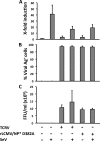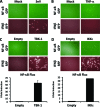Arenavirus nucleoproteins prevent activation of nuclear factor kappa B
- PMID: 22623788
- PMCID: PMC3421694
- DOI: 10.1128/JVI.07240-11
Arenavirus nucleoproteins prevent activation of nuclear factor kappa B
Abstract
Arenaviruses include several causative agents of hemorrhagic fever (HF) disease in humans that are associated with high morbidity and significant mortality. Morbidity and lethality associated with HF arenaviruses are believed to involve the dysregulation of the host innate immune and inflammatory responses that leads to impaired development of protective and efficient immunity. The molecular mechanisms underlying this dysregulation are not completely understood, but it is suggested that viral infection leads to disruption of early host defenses and contributes to arenavirus pathogenesis in humans. We demonstrate in the accompanying paper that the prototype member in the family, lymphocytic choriomeningitis virus (LCMV), disables the host innate defense by interfering with type I interferon (IFN-I) production through inhibition of the interferon regulatory factor 3 (IRF3) activation pathway and that the viral nucleoprotein (NP) alone is responsible for this inhibitory effect (C. Pythoud, W. W. Rodrigo, G. Pasqual, S. Rothenberger, L. Martínez-Sobrido, J. C. de la Torre, and S. Kunz, J. Virol. 86:7728-7738, 2012). In this report, we show that LCMV-NP, as well as NPs encoded by representative members of both Old World (OW) and New World (NW) arenaviruses, also inhibits the nuclear translocation and transcriptional activity of the nuclear factor kappa B (NF-κB). Similar to the situation previously reported for IRF3, Tacaribe virus NP (TCRV-NP) does not inhibit NF-κB nuclear translocation and transcriptional activity to levels comparable to those seen with other members in the family. Altogether, our findings demonstrate that arenavirus infection inhibits NF-κB-dependent innate immune and inflammatory responses, possibly playing a key role in the pathogenesis and virulence of arenavirus.
Figures







Similar articles
-
Arenavirus nucleoprotein targets interferon regulatory factor-activating kinase IKKε.J Virol. 2012 Aug;86(15):7728-38. doi: 10.1128/JVI.00187-12. Epub 2012 Apr 24. J Virol. 2012. PMID: 22532683 Free PMC article.
-
Z proteins of New World arenaviruses bind RIG-I and interfere with type I interferon induction.J Virol. 2010 Feb;84(4):1785-91. doi: 10.1128/JVI.01362-09. Epub 2009 Dec 9. J Virol. 2010. PMID: 20007272 Free PMC article.
-
Self-association of lymphocytic choriomeningitis virus nucleoprotein is mediated by its N-terminal region and is not required for its anti-interferon function.J Virol. 2012 Mar;86(6):3307-17. doi: 10.1128/JVI.05503-11. Epub 2012 Jan 18. J Virol. 2012. PMID: 22258244 Free PMC article.
-
Innate immune response to arenaviral infection: a focus on the highly pathogenic New World hemorrhagic arenaviruses.J Mol Biol. 2013 Dec 13;425(24):4893-903. doi: 10.1016/j.jmb.2013.09.028. Epub 2013 Sep 26. J Mol Biol. 2013. PMID: 24075870 Free PMC article. Review.
-
Comparative analysis of disease pathogenesis and molecular mechanisms of New World and Old World arenavirus infections.J Gen Virol. 2014 Jan;95(Pt 1):1-15. doi: 10.1099/vir.0.057000-0. Epub 2013 Sep 25. J Gen Virol. 2014. PMID: 24068704 Free PMC article. Review.
Cited by
-
Host Cell Restriction Factors of Bunyaviruses and Viral Countermeasures.Viruses. 2021 Apr 28;13(5):784. doi: 10.3390/v13050784. Viruses. 2021. PMID: 33925004 Free PMC article. Review.
-
D471G mutation in LCMV-NP affects its ability to self-associate and results in a dominant negative effect in viral RNA synthesis.Viruses. 2012 Oct 16;4(10):2137-61. doi: 10.3390/v4102137. Viruses. 2012. PMID: 23202457 Free PMC article.
-
Reporter-Expressing, Replicating-Competent Recombinant Arenaviruses.Viruses. 2016 Jul 20;8(7):197. doi: 10.3390/v8070197. Viruses. 2016. PMID: 27447662 Free PMC article. Review.
-
Arenavirus Genome Rearrangement for the Development of Live Attenuated Vaccines.J Virol. 2015 Jul;89(14):7373-84. doi: 10.1128/JVI.00307-15. Epub 2015 May 13. J Virol. 2015. PMID: 25972555 Free PMC article.
-
The S Genome Segment Is Sufficient to Maintain Pathogenicity in Intra-Clade Lassa Virus Reassortants in a Guinea Pig Model.Front Cell Infect Microbiol. 2018 Jul 11;8:240. doi: 10.3389/fcimb.2018.00240. eCollection 2018. Front Cell Infect Microbiol. 2018. PMID: 30050872 Free PMC article.
References
-
- Barton LL. 1996. Lymphocytic choriomeningitis virus: a neglected central nervous system pathogen. Clin. Infect. Dis. 22:197 doi:10.1093/clinids/22.1.197 - DOI - PubMed
-
- Borrow P, Oldstone MB. 1994. Mechanism of lymphocytic choriomeningitis virus entry into cells. Virology 198:1–9 - PubMed
Publication types
MeSH terms
Substances
Grants and funding
LinkOut - more resources
Full Text Sources
Research Materials
Miscellaneous

